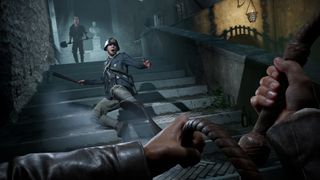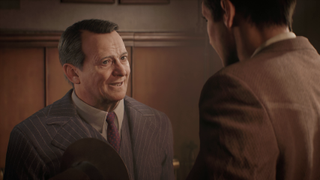Shortly before my hands-on with Indiana Jones and the Great Circle, a developer from MachineGames explains that this is "not action-adventure, but adventure-action". He promises that this isn't just a cinematic skin over the studio's usual FPS combat, instead prioritising the feel of an Indiana Jones adventure. The problem is, that's only half true.
As a statement of intent, it's exactly what you'd want. It certainly wouldn't feel true to the character if Jones was simply going room to room mowing down Nazis like BJ Blazkowicz. You want to see him bash some heads, for sure, but also exploring, escaping, chasing, outwitting, and generally pulling off the impossible. The problem is, I don't think what the studio's made here really is "adventure-action". After roughly three hours with it, I think it's basically just a stealth game.
As my demo takes me from Marshall College to Vatican City to the Pyramids of Giza, more than anything what I'm doing is crouching behind boxes waiting for guards to pass. That's not to say it's bad or boring stealth—it's mostly light and forgiving enough that you can make your way around fairly quickly, and cinematic touches give it extra spice. Stealth kills, for example, require an improvised one-use weapon from the environment each time, meaning you're constantly breaking shovels, wine bottles, fire pokers, and saucepans over Nazi's heads. That's just an old-fashioned good time.
When you do get spotted, it's rarely a mission-ender. Guards seem happy to have a quick fistfight with you rather than running off to raise the alarm, using the simple but satisfying melee combat system. Despite their thunderous impact, your punches rarely attract wider attention, so once the guy in front of you is down, you're free to go back to the shadows. Gunfire is the only thing that'll really bring down the entire Reich on you, and that's easily avoided—your whip can snap weapons out of enemies' hands, at which point they forget they ever had one and their lust for fisticuffs takes over.
It's a slightly chaotic and precarious kind of stealth, by design. I'm sure you can slink through Nazi bases like an unseen ghost if you really put the effort in, but it felt natural to swing between effective sneaking and moments of panicked brawling. It evokes Jones' scrappy, underdog nature—he's not a ninja, he's an improviser.
But equally I don't think there's a ton of meat here for those who do love a tense stealth experience. To support that cinematic feel, guards have been made about as intelligent as the heavy objects you frequently hit them with, and while there are elements of immersive sim design—such as alternate routes to discover—they're all very light touch. That keeps things from getting too slow and cerebral, but when stealth is the core experience, I do worry that the systems here are a bit too shallow to stretch across a whole game.

In Vatican City, I sneak through a fortress taken over by Mussolini's thugs. Its cramped and relatively linear confines are ideal for both learning the stealth system and seeing it at its best, with secrets to discover, locked doors offering shortcuts if their keys can be found, and plenty of isolated guards waiting to be bonked on the head. It's a short but satisfying sequence that leaves me curious to see how the formula widens out from there.
The next section I'm dropped into couldn't be more different. The sprawling desert of Giza is one large, open map that I'm free to walk around as I please, with a smattering of different objectives encouraging me to find my own winding path through it. With Nazi camps dotted all around and patrols marching the sands, stealth is still key—but it's here that I see it at its weakest.
I do enjoy the increased agency and more organic feel—it's up to me where I want to sneak and how, rather than moving through a pre-set series of encounters. But the wide open spaces between camps are frustrating to traverse, with lookouts always ready to spot you and nothing to hide behind, and the camps themselves don't feel well-crafted to encourage player creativity.
Too often the slightly awkward climbing controls funnel you down limited paths or make exiting the scene unintuitive (you can jump up and lift yourself over ledges and obstacles, but it's often unclear which can be traversed and which can't), and the placement of guards and obstacles can feel strangely random. A platform you can conspicuously swing over to has nothing on it and leads nowhere, while an area you're forced to move through to reach an objective has a density of guards you don't really have the tools to get past elegantly.

This tomb raiding sequence is strictly linear and scripted, leading me between insultingly simple puzzles and quite awkward platforming sequences.
Once I discovered a disguise, everything started to make a lot more sense—suddenly I could simply walk past a lot of those guards, with only the occasional officer savvy enough to still see me as a threat. Now I could go wherever I liked with ease, as long as I kept my wits about me. But it just means the friction of those open stealth encounters is replaced with… well, nothing. Empowering, but a little dull. The developer also had to strongly suggest looking for that disguise to me before the session started, and even tell me where it was on the map, to ensure I found it quickly—necessary, perhaps, for a press event where time is limited, but I do wonder how long I could have wandered frustrated without it otherwise, having to sneak everywhere across an entire desert.
Thankfully we don't have to find out. Instead, suitably dressed, I'm able to walk right into a Nazi dig site, and finally do something other than stealth. Down below the sands is an ancient Egyptian tomb ripe for exploring, and I've even got a plucky female sidekick joining me—now this is an Indiana Jones adventure!
But after pining for something other than stealth, when I finally get it, it's less of a breath of fresh air (or dusty, underground air) than I'd hoped. This tomb raiding sequence is strictly linear and scripted, leading me between insultingly simple puzzles and quite awkward platforming sequences that keep popping me queasily into third-person to swing across a gap or hang off a ledge. Players often complain about developers splashing yellow paint everywhere to make it bluntly obvious where you need to go, but The Great Circle has the opposite problem—your next handhold or swing point often blends into the background, making it unclear how to progress.

At the same time, straying off the prescribed path or even just disrupting the exact series of actions of your AI companion is instantly punished. In this instance, many of the rooms are simply swarming with scorpions that quickly sting you to death if you walk where you're not supposed to—I don't think I was ever killed by Nazi fire in my playthrough, but these little creeps certainly drew some blood. That's made worse by the inclusion of a stamina bar (Boo! Hiss!) that harshly limits your sprinting and climbing, adding an artificial tension to traversal (as well as making getting around the large map an unnecessary pain when you're back topside).
There's no real sense of discovery or exploration, as found in the recent Tomb Raider trilogy, but equally this sequence isn't slick or exciting enough to stand alongside the more linear setpieces of an Uncharted. The further The Great Circle strays from its core stealth formula, the more it seems to struggle with the actual mechanics of Jones' escapades.

Environments are remarkably lavish, and clearly painstakingly researched.
It's a shame, because while I don't think the game quite finds the adventure of the movies, it does a wonderful job recreating their look and sound. Environments are remarkably lavish, and clearly painstakingly researched—some imitating specific places from the films, such as Marshall College, others real historical sites. Jones himself looks like he's stepped right out of the silver screen, and voice actor Troy Baker's impression of him is startlingly accurate at times—even if he sometimes sounds a bit more like grumpy old Harrison Ford rather than charismatic young Harrison Ford.
The story weaves elegantly into the existing fabric of the series, using familiar characters in effective ways and introducing new ones that fit seamlessly in this cinematic world. Even in my short time with the game I get to see the beginning of an interesting arc for Jones, one that looks to give him some more emotional depth without betraying his on-screen persona. Set between Raiders and The Last Crusade, this really does feel like part of the canon, rather than just a spin-off.

The movie part, then, is nailed—it's the videogame part that doesn't seem to quite click. If anything, the two seem to grind against each other, the wonderful realism of the cutscenes and environments making the more gamified elements jarring. In one cutscene, I find myself genuinely touched by a moment where Jones greets an old friend and gives him an emotionally received gift. About ten minutes later, I'm discovering I can sprint for slightly longer if I make Jones steal lemons from the Nazis and eat them whole to boost his stamina. Maybe if he'd known that in Raiders he wouldn't have had so much trouble running away from that boulder?
There's a lot about The Great Circle that's impressive, especially its lush visuals, and though its sneaking is uneven, its little moments of chaos give it a distinct and charming personality. But the feeling I can't shake is that I'd rather be playing that adventure-action game MachineGames pitched than the stealth game compromise it's actually making.

 4 days ago
8
4 days ago
8






:quality(85):upscale()/2024/10/31/801/n/49351082/b84152bf6723c91b32cc73.86821940_.jpg)


 English (US) ·
English (US) ·